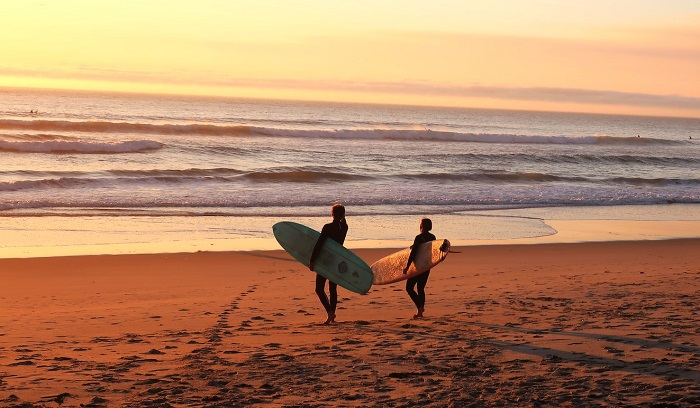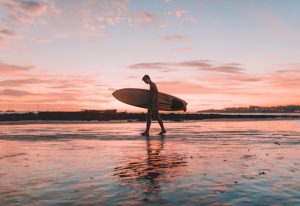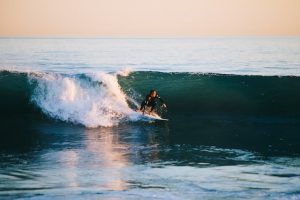Beginning surfers have something special: passion. If they connect to the thrill of riding waves, nothing else matters; not safety, not effectiveness, not even reason. So it’s only natural that in a feverish effort to get maximum water time and to catch every wave in sight, new surfers often make pretty major mistakes that could negatively affect their progress or even their health. So here are some common mistakes made by beginning surfers.
1. Riding the Wrong Board
New surfers are often so stoked by watching more advanced surfers shredding the best waves of ever set on their little 5-foot, high-performance surfboards that they decide to ride the same equipment. However, that can be a major problem in that shorter, thinner boards don’t offer any of the control or flotation required for learning to surf the right way.
How to Choose the right board for you?
Remember, a short board will be strangely light and loose in comparison to your longboard, so you don’t want to go too short at first. Don’t go too small or thin. You will have a hard time catching waves and will bog down in weak surf.
In terms of length, from 6’10” to 7’2″ is a good range depending on your size. Regardless, be sure your board is at least one head taller than you. Around 19-21″ wide is solid but be sure the surfboard has plenty of thickness to float you (around 2+ inches thick is average).
If you want sharper shortboard-style turns then avoid funboards (wide surfboards with rounded longboard-style noses).
Try to stay within 19-20 inches max. However, funboards will give you more wave-catching ease, so think about what’s most important to you. Many longboarders ride funboards, but they aren’t technically considered “short boards.”
Your local surf shop might tell you differently, but a fish surfboard is not the best choice for a transition. Sure, fish surfboards are fun, but these surfboards’ wide tails and quirky fin configurations can be loose and squirrely and really require a higher skill level and take some getting used to.
2. Picking the Wrong Spot to Surf
The bottom line is that inexperienced surfers should not pick the most critical surf spot in town to practice their art. Instead, they should seek out the opposite. An easy, rolling wave with deep water is very helpful since a reef will only slow down the learning process and cause possible injuries. If you live on the East Coast of the U.S., finding a mushy wave is pretty easy, but other areas may warrant you to check weather forecasts to be sure that conditions won’t change too quickly. There is absolutely no shame in learning to surf in small, unpopular waves. In fact, others will be thankful!
So when choosing a place to surf, be sure that it’s not crowded and the waves are not too critical. Both factors will negatively affect your learning process and make your early sessions less enjoyable.
3. Surfing Alone
Okay, this is not to say that you need to surf with a group. Instead, you will find that surfing with one or two friends will not just make you safer but also push you to surf better.
First and foremost, surfing can be dangerous, especially for new surfers. Rip currents, rising swells, sharks, hold-downs, and jellyfish reactions are just some of the possible dangers you might run into. Having someone there to help or AT LEAST report your missing is pretty important.
On a lighter note, surfing with friends fosters competition and learning. Watching the victories and failures of others will help you learn what to do and what to avoid. Plus, that rush of competitive spirit will move you to be your best and try new techniques along the way.
4. Neglecting Fitness
Surfing is after all a demanding physical activity and it, therefore, demands physical fitness. For the young folks, just surfing a lot might be enough to keep them loose and strong, but for older beginners, a little cross-training and stretching is essential to make each surf session more productive and less stressful to the knees and back.
Fitness Aspects You Should Develop
Stretching – Stretching is the way to keep all your muscles loose and vital. Some recent studies have shown that stretching before exercise may not be as helpful as previously thought; however, it’s still vital to staying loose.
A light stretch in the morning after you wake up or a more extensive yoga routine in the afternoon after a session can help avoid serious injury by making your muscles and ligaments warm and more pliable. You don’t have to make a show of it at the beach. Instead, go through your favorite stretch routine in the living room while watching a surf video to amp you up for a forthcoming session.
Swimming – Swimming is the best overall exercise you can do to prepare for surfing. No other activity can work your paddling muscles: shoulders and back. Also, swimming promotes cardiovascular endurance and muscle coordination which are essential in getting back and forth from the beach to the lineup and riding waves effectively. But forget about being a good surfer for a second and realize that swimming is the only exercise that is also a life-saving skill. If you plan to surf any waves of consequence or even where there might be a current or riptide, swimming is a required exercise. Moreover, if you don’t surf every day, regular swimming will minimize soreness and maximize performance when you do get to the beach.
Strengthen your Upper Body – Swimming is great for this, but to really get the most out of your paddling speed and endurance, you may want to add a daily set of push-ups to your routine. They don’t take much time and you don’t have to go anywhere to bust out 30 or 40 push-ups, but the payoff is powerful as they elongate and strengthen the exact muscles you need to dig in and get into waves early.
Strengthen your Knees and Lower Back – Again, you don’t need to go crazy here. Just hop on a bike and ride for 30 minutes three times a week. Pedaling will build endurance muscles throughout your entire leg network while stretching and strengthening your lower back. Keeping those knees moving is essential to staying loose into your “later” years.
Eat Right and Hydrate – Okay, so eating right is important to more than just surfing, but let’s stay focused here. Loading up on junk food before the session may have rendered no ill effects when you were 20, I can assure you that that same behavior in your 30s and 40s will result in sluggishness and overall lethargy right when you need energy most. Instead, surf light by filling up on fruits and veggies and grains. A big bowl of granola and a couple of bananas or watermelon would be perfect to keep you energized for hours. Even keep a snack in your car for a mid-session boost. But most importantly, stay hydrated. Drink loads of water before and after a surf. The sun, the salt, and the insane amount of aerobic activity that comes along with a day of surfing can deplete even the fittest of essential moisture.
Final Thoughts
So there you have it. The most common mistakes made by beginning surfers. As your surfing progresses, some of this will become second nature, but regardless of your level of experience, it’s important to understand these simple concepts to be a healthier and happier surfer. Now, grab yourself some granola, a big glass of water, and go rip! Oh yeah, don’t forget your sunscreen.



